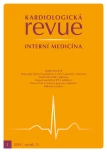The role of nebivolol in the treatment of cardiovascular diseases
Authors:
Málek F.
Authors‘ workplace:
Kardiocentrum, Nemocnice Na Homolce, Praha
Published in:
Kardiol Rev Int Med 2019, 21(1): 50-53
Overview
Nebivolol is a third generation beta blocker with vasodilating properties. It has been tested in broad experimental and clinical research and has been approved for the treatment of arterial hypertension, ischaemic heart disease and chronic heart failure. Nebivolol improves endothelial function, which is an advantage in arterial hypertension. It has a positive effect on coronary perfusion and affects the size of myocardial ischaemia. Nebivolol is indicated in patients with stable coronary artery disease and after myocardial infarction. The positive effect of nebivolol on systolic and diastolic left ventricular function has been tested in a mortality study showing its benefit on mortality and morbidity of older patients with chronic heart failure. Thanks to its unique pharmacological qualities, nebivolol is well tolerated in elderly patients.
Keywords:
cardiovascular disease – nebivolol – endothelial function – coronary flow – left ventricular function – heart failure – tolerability
Sources
1. López-Sendón J, Swedberg K, McMurray J et al. Expert consensus document on beta-adrenergic receptor blockers. Eur Heart J 2004; 25(15): 1341– 1362. doi: 10.1016/ j.ehj.2004.06.002.
2. Mangrella M, Rossi F, Fici F et al. Pharmacology of nebivolol. Pharmacol Res 1998; 38(6): 419– 431. doi: 10.1006/ phrs.1998.0387.
3. Howlett JG. Nebivolol: vasodilator properties and evidence for relevance in treatment of cardiovascular disease. Can J Cardiol 2014; 30 (Suppl 5): S29– S37. doi: 10.1016/ j.cjca.2014.03.003.
4. Tzemos N, Lim PO, MacDonald TM. Nebivolol reverses endothelial dysfunction in essential hypertension: a randomized, double-blind, crossover study Circulation 2001; 104(5): 511– 514.
5. Caglar N, Dincer I. Comparison between nebivolol and ramipril in patients with hypertension and left ventricular hypertrophy: a randomized open blinded end-point (PROBE) trial. Eur Rev Med Pharmacol Sci 2011; 15(12): 1359– 1368.
6. Fountoulaki K, Dimopoulos V, Giannkakoulis J et al. Left ventricular mass and mechanics in mild-to-moderate hypertension: effect of nebivolol versus telmisartan. Am J Hypertens 2005; 18(2 Pt 1): 171– 177. doi: 10.1016/ j.amjhyper.2004.08.039.
7. Williams B, Mancia G, Spiering W et al. 2018 ESC/ ESH Guidelines for the management of arterial hypertension. Eur Heart J 2018; 39(33): 3021– 3104. doi: 10.1093/ eurheartj/ ehy339.
8. Widimský J, Filipovský J, Ceral J et al. Doporučení pro diagnostiku a léčbu arteriální hypertenze ČSH 2017. Hypertenze a kardiovaskulární prevence 2018; 7 (Suppl): 1– 19.
9. Egan B, Gradman A, Ali S et al. Cardiovascular outcomes with nebivolol, atenolol and metoprolol in patients with hypertension: a large, retrospective, propensity score-matched cohort study. J Am Call Cardiol 2017; 69 (11 Suppl): 1691. doi: 10.1016/ S0735-1097(17)35080-5.
10. Packer M, Bristow MR, Cohn JN et al. The effect of carvedilol on morbidity and mortality in patients with chronic heart failure. U.S. Carvedilol Heart Failure Study Group. N Engl J Med 1996; 334(21): 1349– 1355. doi: 10.1056/ NEJM199605233342101.
11. CIBIS-II Investigators and Committees. The Cardiac Insufficiency Bisoprolol Study II (CIBIS-II): a randomised trial. Lancet 1999; 353(9146): 9– 13.
12. MERIT-HF Study Group. Effect of metoprolol CR/ XL in chronic heart failure: metoprolol CR/ XL randomised intervention trial in-congestive heart failure (MERIT-HF). Lancet 1999; 353(9169): 2001– 2007.
13. Packer M, Fowler MB, Roecker EB et al. Effect of carvedilol on the morbidity of patients with severe chronic heart. Failure: results of the Carvedilol Prospective Randomized Cumulative Survival (COPERNICUS) study. Circulation 2002; 106(17): 2194– 2199.
14. Flather MD, Shibata MC, Coats AJ et al. SENIORS Investigators. Randomized trial to determine the effect of nebivolol on mortality and cardiovascular hospital admission in elderly patients with heart failure (SENIORS). Eur Heart J 2005; 26(3): 215– 225. doi: 10.1093/ eurheartj/ ehi115.
15. Edes I, Gasior Z, Wita K. Effects of nebivolol on left ventricular fiction in elderly patients with chronic heart failure: results of the ENECA study. Eur J Heart Fail 2005; 7(4): 631– 639. doi: 10.1016/ j.ejheart.2004.10.015.
16. Ponikowski P, Voors AA, Anker SD, et al. 2016 ESC Guidelines for the diagnosis and treatment of acute and chronic heart silure. The Task Force for the diagnosis and treatment of acute and chronic heart failure of the European Society of Cardiology (ESC). Eur Heart J 2016; 37(27): 2129– 2200. doi: 10.1093/ eurheartj/ ehw128.
17. Špinar J, Hradec J, Špinarová L et al. Souhrn Doporučených postupů ESC pro diagnostiku a léčbu akutního a chronického srdečního selhání z roku 2016. Cor Vasa 2016; 58(5): e530– e568.
Labels
Paediatric cardiology Internal medicine Cardiac surgery CardiologyArticle was published in
Cardiology Review

2019 Issue 1
Most read in this issue
- Comparison of the benefits of FGM and CGM for different clinical scenarios in patients with type 1 diabetes mellitus
- The role of nebivolol in the treatment of cardiovascular diseases
- The most common causes of hospitalisation and death in patients with diabetes – results of the National Diabetology Registry
- Screening of asymptomatic carotid atherosclerosis in diabetic patients and its association with ankle-brachial index
